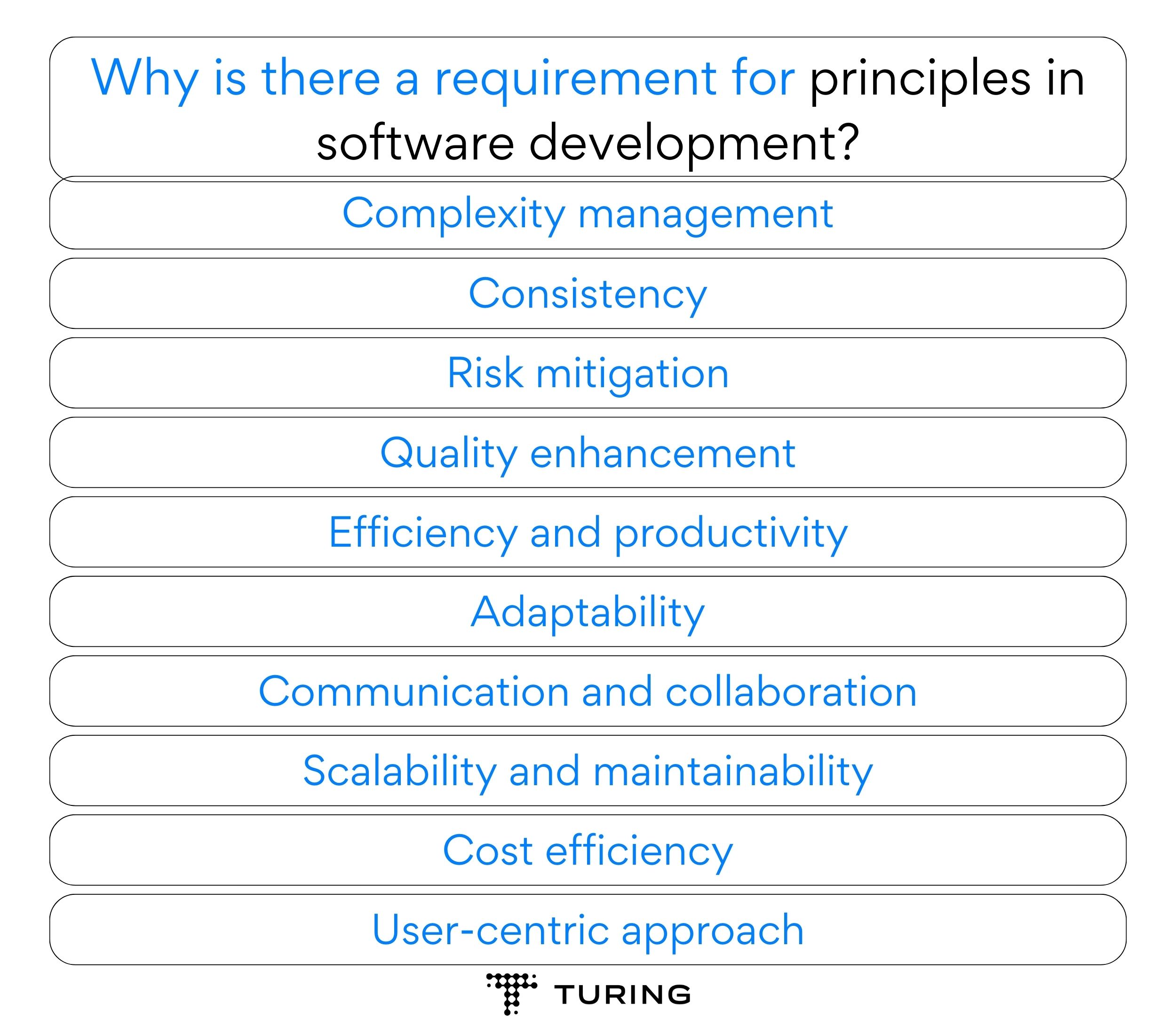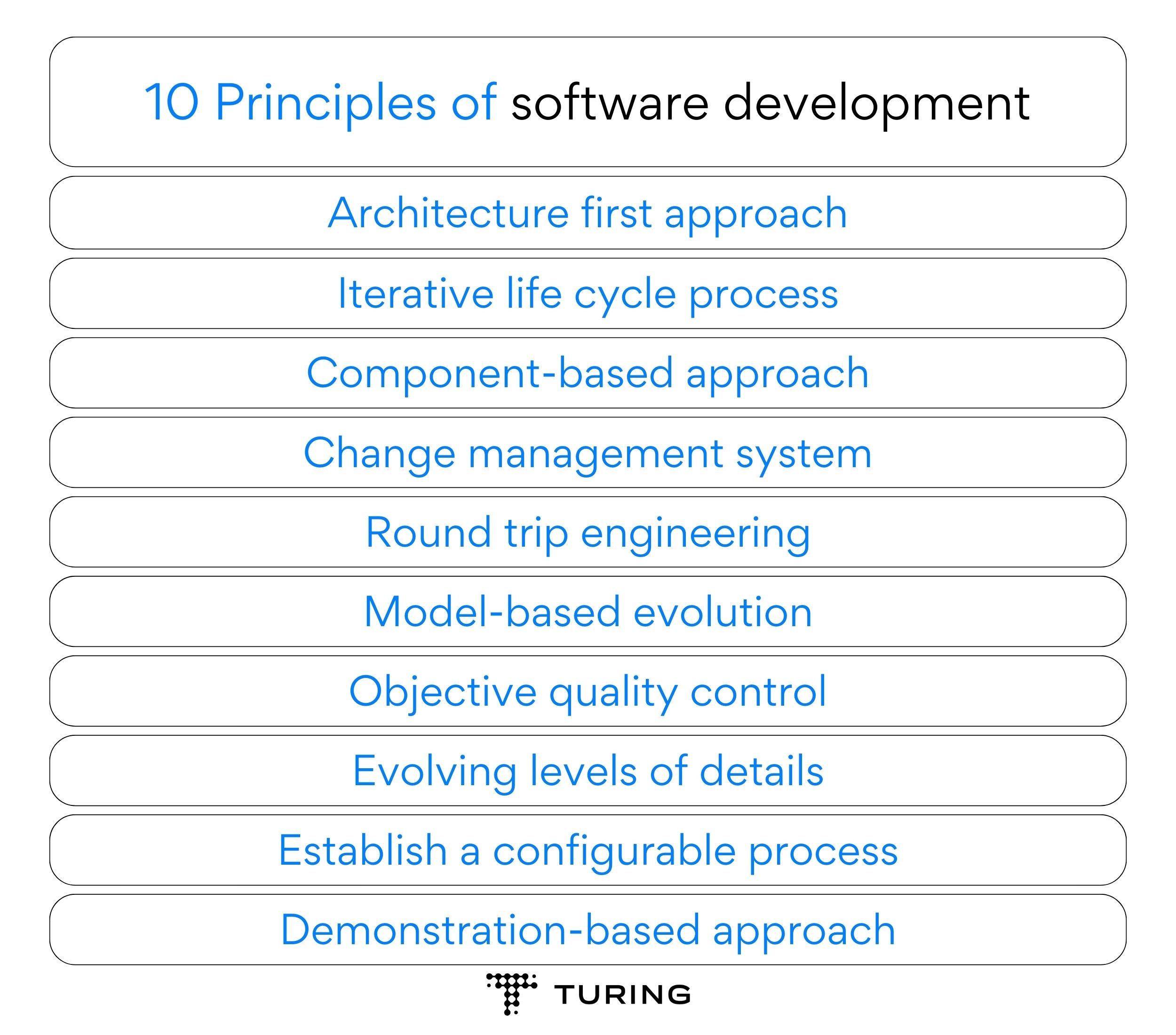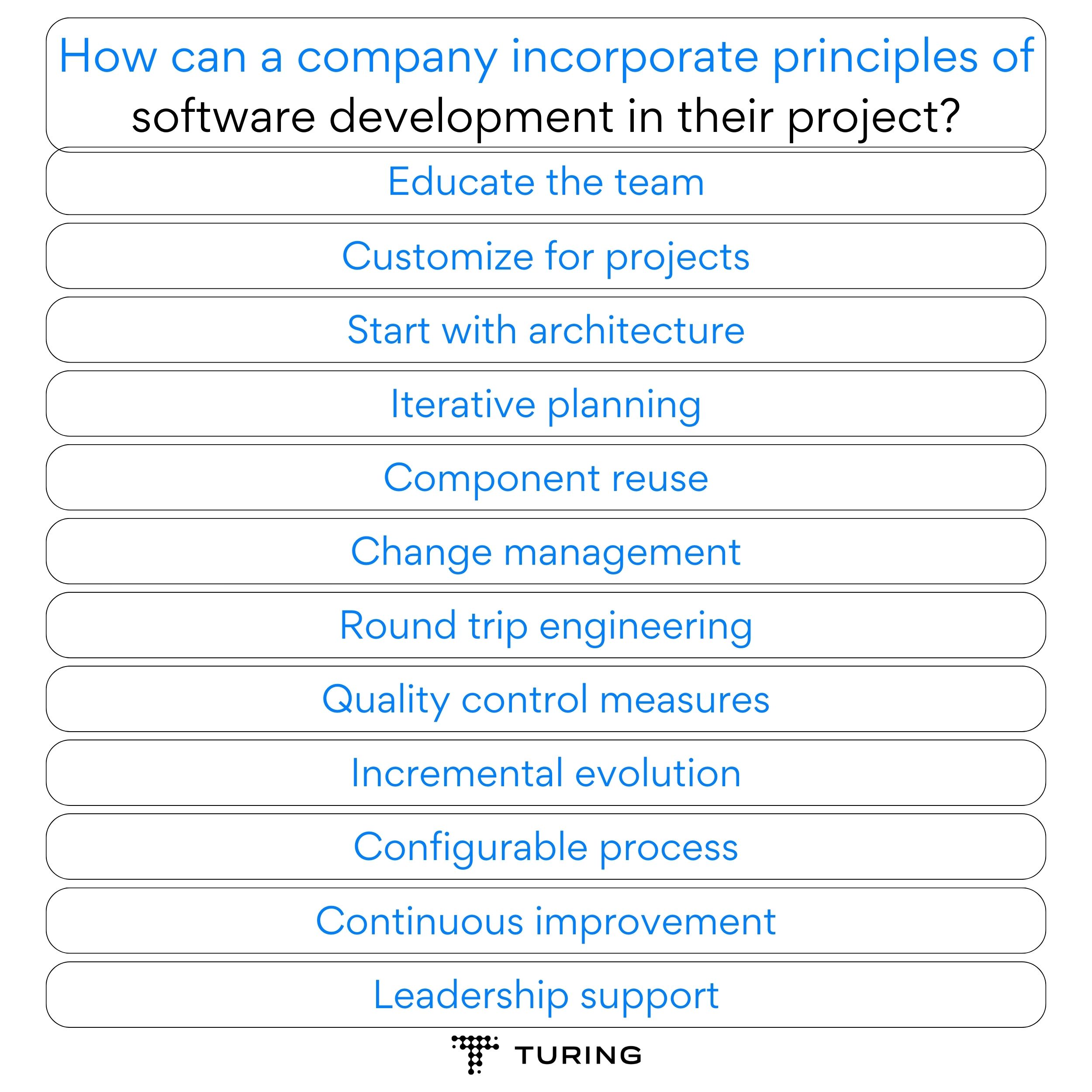10 Principles of Software Development You Must Know!
The software development industry is fast-paced and the changes are so rapid that you need a well-defined process and principles to guide you in order to succeed in your projects. These principles of software development provide a framework for creating software solutions that are not only functional but also reliable, maintainable, and adaptable.
In this comprehensive guide, we will be taking a look at the main principles of software development, why the principles are necessary, and how you can incorporate these principles in your software development.
Why is there a requirement for principles in software development?

Why is there a requirement for principles in software development?
Principles in software development serve as guiding rules and fundamental concepts that help streamline the process, enhance the quality of the software, and improve the overall efficiency of development projects. These principles are not just theoretical concepts; they provide practical strategies to tackle the complexities and challenges that arise during the software development lifecycle. Here’s why there is a requirement for principles in software development:
- Complexity management: Software development involves intricate designs, interactions, and functionalities. Principles offer a structured approach to managing this complexity, breaking down the process into manageable components and stages.
- Consistency: Principles provide a consistent framework for software development. They help ensure that all team members adhere to a common set of guidelines, leading to uniformity in code quality, design patterns, and project execution.
- Risk mitigation: Developing software is fraught with uncertainties and risks. Principles such as iterative development and change management help identify and mitigate risks early in the process, reducing the chances of costly errors later on.
- Quality enhancement: Principles like objective quality control and modular design contribute to the improvement of software quality. By implementing these principles, developers can identify and rectify defects, leading to a more reliable and stable end product.
- Efficiency and productivity: Principles promote efficiency by offering proven methodologies and best practices. For instance, the component-based approach encourages code reuse, saving time and effort in development. This ultimately boosts productivity across the development team.
- Adaptability: The software industry is dynamic, with evolving user requirements and technological advancements. Principles such as evolving levels of details and model-based evolution allow for flexible adaptation to changes, ensuring that the software remains relevant over time.
- Communication and collaboration: Principles promote effective communication within development teams and with stakeholders. Clear guidelines and shared understanding enable smoother collaboration, leading to better decision-making and problem-solving.
- Scalability and maintainability: Principles like architecture-first approach and modularity lay the foundation for scalable and maintainable software. Designing a solid architecture and breaking down software into modules make it easier to extend, modify, and enhance the system as needed.
- Cost efficiency: Applying principles can reduce development costs in the long run. By catching errors early, avoiding rework, and promoting efficient practices, software development becomes more cost-effective.
Also, read: Did You Know about This Hidden Cost of Hiring A Software Development Team? - User-centric approach: Principles help developers align their efforts with user needs and expectations. By following principles like demonstration-based approaches, developers can ensure that the software addresses real-world problems and provides meaningful solutions.
Principles in software development provide a roadmap for creating high-quality software that meets user needs, adapts to changes, and stands the test of time. They offer a structured approach to tackling challenges, enhancing collaboration, and achieving successful outcomes in an ever-evolving digital landscape.
10 principles of software development

10 Principles of Software Development
Let’s take a look at the 10 major software development principles that you should incorporate while creating your project roadmap.
-
Architecture first approach
At the heart of successful software lies a strong architectural foundation. The architecture-first approach emphasizes the significance of devising a robust architecture early in the development cycle. By addressing architectural intricacies in the initial stages, developers can mitigate ambiguities, enhance decision-making, and optimize the overall productivity of the project. -
Iterative life cycle process
The iterative life cycle process entails a cyclic approach to development, where stages like requirement gathering, design, implementation, and testing are revisited to refine and improve the software. This method allows for the identification and elimination of risks in the early stages. By continuously iterating through the development cycle, software projects become more adaptable to evolving requirements and changes in the development landscape. -
Component-based approach
The component-based approach capitalizes on the reuse of pre-defined functions and code components. This approach not only accelerates development but also ensures consistency, reduces errors, and promotes maintainability. By integrating reusable components, developers can streamline the design process and create software that is not only efficient but also easy to manage and upgrade. -
Change management system
Change is an inevitable part of software development. A robust change management system facilitates controlled and systematic handling of changes. It involves identifying, evaluating, and implementing changes while maintaining the stability and quality of the software. Such a system ensures that the software remains adaptable to dynamic requirements and minimizes disruptions caused by changes. -
Round trip engineering
Round trip engineering integrates code generation and reverse engineering in a dynamic environment. This principle enables developers to work seamlessly on both aspects, ensuring consistency and accuracy between code artifacts and design models. Automatic updates of artifacts enhance collaboration, reduce errors, and contribute to the overall efficiency of the development process. -
Model-based evolution
In model-based evolution, software development relies on graphical and textual representations to adapt to changing requirements. Models provide a conceptual framework for understanding the software’s architecture and behavior. This approach empowers developers to evolve the software’s design and functionality based on real-time feedback, ensuring that the end product aligns with user needs. -
Objective quality control
Quality control is paramount in software development. The objective quality control principle emphasizes defining and adhering to quality metrics, checklists, and improvement measures. By consistently monitoring and improving quality, software projects can minimize defects, enhance user satisfaction, and ensure that the final product meets established standards. -
Evolving levels of details
Planning intermediate releases with evolving levels of detail enables progressive development. This principle promotes incremental refinement of use cases, architecture, and design details. By breaking down the development process into manageable stages, teams can adapt to changes and enhance the software’s flexibility and responsiveness to user needs. -
Establish a configurable process
Software development is not one-size-fits-all. The establishment of a configurable process enables customization based on project requirements. This principle ensures that methodologies, tools, and practices can be tailored to align with specific project goals and constraints, resulting in a more efficient and effective development process. -
Demonstration-based approach
Effective communication with stakeholders is essential in software development. The demonstration-based approach involves showcasing working software to stakeholders. Demonstrations offer a clear representation of the problem domain, approaches used, and proposed solutions. This approach fosters engagement, encourages feedback, and enhances productivity and quality.
How can a company incorporate principles of software development in their project?

How can a company incorporate principles of software development in their project?
Incorporating principles of software development into a company’s projects is essential for ensuring the creation of high-quality, efficient, and adaptable software solutions. Here’s a step-by-step guide on how a company can effectively integrate these principles into their project lifecycle:
- Educate the team: Start by educating the development team about the principles of software development. Conduct workshops, training sessions, and provide resources to help them understand the importance and implications of each principle.
- Customize for projects: Tailor the principles to fit the specific needs of each project. Not all principles may apply equally to every project, so prioritize and customize their application accordingly.
- Start with architecture: Begin the project with an architecture-first approach. Allocate time to define and design the software’s architecture, addressing potential challenges and ambiguities early on.
- Iterative planning: Embrace an iterative life cycle process. Break down the project into smaller iterations, focusing on requirement gathering, design, implementation, and testing. Continuously revisit and refine these stages to accommodate changes and improve the project’s direction.
- Component reuse: Encourage a component-based approach. Develop a library of reusable components and encourage developers to reuse existing code to expedite development, ensure consistency, and reduce errors.
- Change management: Implement a change management system that tracks and assesses changes to the project. Create a systematic process for reviewing, evaluating, and implementing changes while maintaining stability and quality.
- Round trip engineering: Integrate round trip engineering by using tools that facilitate automatic updates between code and design artifacts. This ensures consistency and accuracy throughout the development process.
- Quality control measures: Establish objective quality control measures. Define quality metrics, checklists, and improvement plans to ensure that the software meets high standards and user expectations.
- Incremental Evolution: Plan for evolving levels of detail. Develop the project incrementally, refining use cases, architecture, and design details with each iteration to adapt to changing requirements and ensure alignment with user needs.
- Configurable process: Implement a configurable process that allows teams to choose methodologies, tools, and practices that best suit the project’s requirements. Ensure flexibility while maintaining consistency across projects.
- Continuous improvement: Encourage a culture of continuous improvement. Regularly assess the project’s adherence to principles, identify areas for enhancement, and implement lessons learned in future projects.
- Leadership support: Ensure that company leadership understands the value of these principles. Leadership support can create a conducive environment for their implementation and ensure that the necessary resources are allocated.
By incorporating these principles into their projects, companies can establish a robust foundation for the development process. These principles guide decision-making, enhance collaboration, and result in software solutions that are not only technically sound but also responsive to changing market demands and user needs.
Real-life examples of companies using principles of software development
Here are some of the globally renowned companies that have successfully incorporated the principles of software development to scale their business:
-
Netflix – Architecture First Approach
Netflix’s success is attributed in part to its strong architecture-first approach. By focusing on building a scalable and modular architecture, Netflix was able to accommodate millions of users while ensuring seamless streaming experiences. Challenges included handling the complexities of content delivery and user personalization. The outcome was a resilient system capable of handling spikes in demand, setting a benchmark for other streaming platforms. -
Microsoft – Iterative Life Cycle Process
Microsoft’s adoption of an iterative life cycle process is evident in its Windows operating system releases. Each version goes through multiple cycles of requirement gathering, design, implementation, and testing. This approach allows Microsoft to respond to evolving user needs and address issues promptly. Challenges include maintaining backward compatibility and managing feature scope. The outcome is a stable and adaptable operating system that remains relevant over time. -
Google – Component-Based Approach
Google’s development of the Android operating system showcases the benefits of a component-based approach. By reusing components like the Android runtime and user interface elements, Google accelerated the development of diverse devices. Challenges involved ensuring consistency across devices with varying hardware capabilities. The outcome was a flexible ecosystem of devices that share core functionalities while catering to individual device requirements. -
Amazon – Change Management System
Amazon’s e-commerce platform exemplifies effective change management. The company continuously deploys updates to its website and services to enhance user experience. Challenges include maintaining service availability during updates and avoiding regressions. The outcome is a dynamic platform that evolves seamlessly, ensuring customers have access to new features without disruptions. -
Facebook – Round Trip Engineering
Facebook’s development process involves extensive round trip engineering, enabling rapid updates and feature additions. The social media platform consistently integrates code generation and reverse engineering to maintain code quality. Challenges encompass handling a vast codebase and ensuring timely updates. The outcome is a platform that evolves swiftly while minimizing errors and maintaining code coherence. -
Tesla – Model-Based Evolution
Tesla’s electric vehicles showcase the advantages of model-based evolution. Through over-the-air updates, Tesla can introduce new features, improve performance, and address issues without physical recalls. Challenges include ensuring updates do not compromise safety and reliability. The outcome is a fleet of vehicles that continually improves and aligns with customer preferences. -
NASA – Objective Quality Control
NASA’s space missions exemplify objective quality control. The organization adheres to rigorous quality metrics, checklists, and testing procedures to ensure mission success and crew safety. Challenges encompass the high stakes of space exploration and the need for faultless systems. The outcome is successful missions that push the boundaries of human exploration.
Conclusion
Navigating the intricate landscape of software development requires a thorough understanding and implementation of its fundamental principles. From architecture-first strategies to demonstration-based approaches, each principle plays a vital role in shaping the trajectory of software projects. By adhering to these principles of software development, developers can create software solutions that are not only functional but also adaptable, reliable, and in alignment with the ever-evolving demands of the industry. Through the application of these principles, the realm of software development continues to advance, providing innovative solutions that drive progress in the digital era.
If you’re looking to scale your software development and need a team of expert software developers, you can try Turing Teams. You get full-time development resources customized to a variety of business needs, governance and controls, and technical requirements.
FAQs
-
What is a software design principle?
A software design principle is a fundamental guideline or concept that serves as a foundation for creating effective and efficient software solutions. These principles offer overarching strategies to handle the complexities of software design, ensuring that the resulting systems are well-structured, maintainable, and adaptable. They guide decisions on architecture, module organization, code structure, and other design aspects to achieve high-quality software development outcomes. -
What are the key principles of software engineering?
The key principles of software engineering encompass a set of fundamental guidelines that shape the development and maintenance of software systems. These principles emphasize systematic approaches to design, development, and problem-solving, focusing on aspects such as modularity, abstraction, reusability, and maintainability. They promote efficient project management, collaboration, and adherence to best practices throughout the software lifecycle, ultimately leading to the creation of reliable, high-quality software solutions. -
What is software design principles in software engineering?
Software design principles in software engineering refer to foundational guidelines and concepts that inform the process of creating well-structured, efficient, and maintainable software systems. These principles provide a framework for making design decisions that address various aspects such as modularity, cohesion, coupling, abstraction, and separation of concerns. By adhering to these principles, software engineers ensure that their designs are robust, adaptable, and able to meet evolving requirements while minimizing complexities and potential pitfalls in the development process.
Tell us the skills you need and we'll find the best developer for you in days, not weeks.












